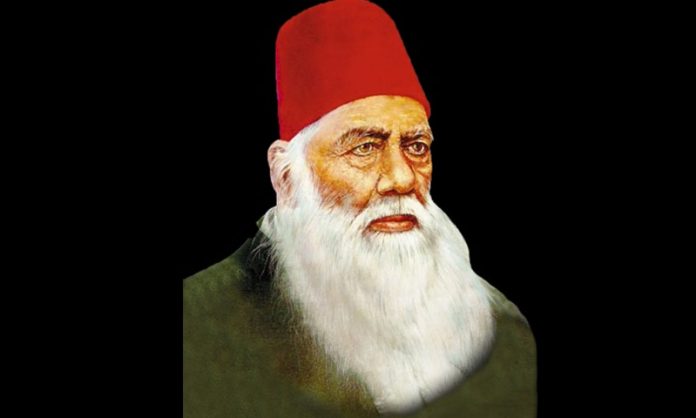Maulana Shibli Naumani was born in May 1857 at a village near Azamgarh (UP). His father who was a prominent member of the local bar came under spell of Sir Syed Ahmad Khan at a time when Shibli had already received his education in the old Islamic madrassah under a celebrated scholar Maulana Muhammad Faruq and was looking for a get a suitable job in any government office. not willing to be well-versed with English language and literature. After trying in vain for some years to, Shibli succeeded to be appointed as Assistant Professor of Arabic at the Aligarh College where he became Sir Syed’s friend and one of his best helpmates. Sir Syed who was highly impressed by his learning provided him all the facilities in the compound of his own bungalow. Moreover, he found a library with the richest collection of books and a wonderful opportunity to meet scholars like Professor Sir Thomas Arnold. It was here in this highly intellectual atmosphere that he wrote many scholarly papers. His first paper Mussalmanon ki Guzashta Ta’lim was read before the Muhammadan Educational Conference in 1887.
Maulana Shibli Naumani is considered as the father of modern history in Urdu. He has produced several works based on historical research, especially on Islamic history. A series of biographies started with Al-Mamun, a biography of Mamun-ur-Rashid published in 1887. Seerat-un- Nauman was published in 1892. The next biography was of Imam Abu Hanifa that appeared in 1893. The third one was Al-Faruq, duly considered as his masterpiece. Later on, he published two more biographies of Imam Ghazali and Maulana Rumi. From time to time Shibli wrote many learned articles and essays to enrich Urdu literature like Al-Jizyah, Kutub Khana-i-Sikandriyah, Shi’r-ul-Ajam, Ilm-ul-Kalam. Muvazina-e- Anis-o-Dabir that was published in 1907 is an excellent piece of his literary work. The most popular and classical biography he wrote was of the Holy Prophet entitled Seerat un Nabi. It is in seven volumes but he was author of only the first volume. The rest of the work was completed by his learned pupil and devoted successor Maulana Syed Suleman Nadvi.
The entire work of Shibli’s essays and articles has been put together in an eight-volume edition of Maqalat-i-Shibli edited by Syed Suleman Nadvi.
Shibli was, indeed, highly impressed by Gibbon, the greatest of the English historians and Ranke, a German historian who revolutionized historical methods in the West in the 19th century. He frankly acknowledged that Ranke was the greatest European historian of the modern times and the pioneer of a new school in historiography. He admitted in a letter that he found in Sir Syed’s library wealth of a new learning that undoubtedly broadened his outlook and opened new vistas before him. As long as he stayed at Aligarh College, he served the cause of Aligarh movement by propagating its ideals and objectives, which aimed at raising the intellectual and educational level of the Indian Muslims. He was also a poet and therefore would write Qasida whenever some prominent visitor came to Aligarh. He accompanied the delegations, which visited Bhopal and Hyderabad to raise funds for the college. But his ideas changed after he left Aligarh College soon after the death of Sir Syed in 1898. He was of the view that the Muslims of the Subcontinent really needed a modified form of the old system and not the new, which was being followed at Aligarh. He criticized the mercenary attitude of the students and referred to Aligarh College as “An Institution for Training in Slavery”. Probably his friend Abdul Halim Sharar was right to comment that Shibli had speculated that “by becoming the head of religious ulama, he would get a status and authority, which was even beyond Sir Syed Khan”.
Shibli had secured the status of a national figure owing to his prolific writings on historical, religious and literary subjects. Now on the priority was his association with the Nadwa. He worked hard to realize his dreams and make it a powerful institution. Being in charge of the Dar-ul-Uloom, he made significant changes in the curriculum. Study of English he made compulsory in the Madrassahs. Another painstaking task he rendered was to select promising students and train them to spread his message to the masses. In this regard the two youngsters who received his special attention were Syed Suleman Nadvi and Maulana Abul Kalam Azad. Both of them duly proved to his literary and political successors. Unfortunately there were some elements of arrogance and egotism, which made him persona non grata. In 1913, he was forced to resign from Nadva that he thought was imperfect without him. But before he died in 1914, he did another monumental work and that was to establish at Azamgarh an academy of authors well-known as Dar-ul-Musannifin, which has produced numerous authors since 1914. It has become the leading center of Muslim India and its mouthpiece Ma’arif is considered as the most influential journal of the Muslim community. Dar-ul-Musannifin continues its valuable service of exploring writers till today. Maulana Shibli donated his library, his family bungalow and his garden to house the Academy of Dar-ul-Musannifin. He did not survive to see the organization at work. However his able successor Syed Suleman Nadvi carried out his work quite efficiently. Shibli’s multidimensional services especially his literary achievements were acknowledged all over the Muslim world. In 1892 the Sultan of Turkey conferred on him “Tamgha-e-Majidi” while the British Government gave him the title of “Shamsul Ulama” in 1894.
This article was last updated on Wednesday, Jan 04, 2006






